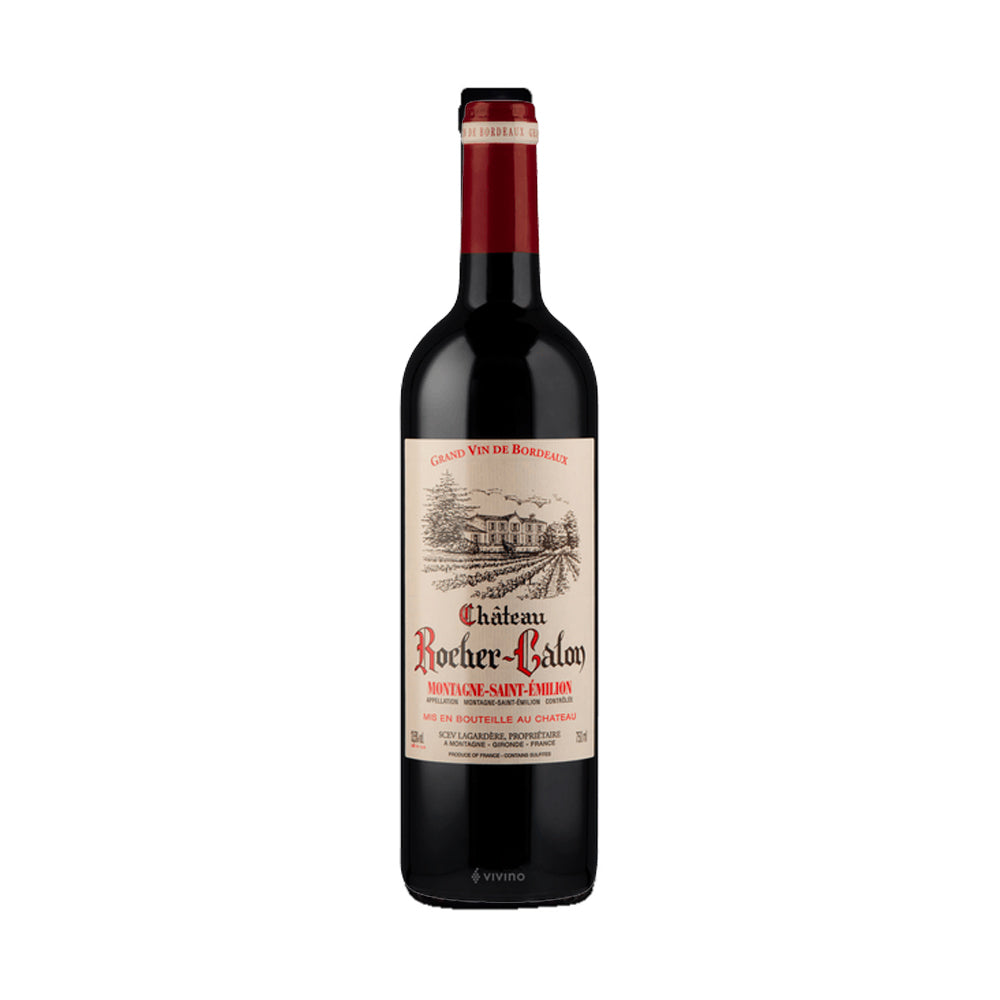
Chateau Rocher-Calon | Montagne
DENOMINATION: Bordeaux Supérieur AOC
TYPE: red
GRAPE VARIETY: Merlot 70%, Cabernet franc 30%
REGION OF ORIGIN: France, Bordeaux
AGEING POTENTIAL: 3/4 years
SERVING TEMPERATURE: 18° C
GLASS: large red wine glass
ALCOHOL: 13,5% vol.
FORMAT: 75 cl
THE WINE
TECHNICAL SPECIFICS
FRESHNESS: ◼︎◼︎◼︎◼︎◻︎
BODY: ◼︎◼︎◼︎◼︎◼︎
SAPIDITY: ◼︎◼︎◼︎◼︎◻︎
SOFTNESS: ◼︎◼︎◼︎◼︎◻︎
TANNIN: ◼︎◼︎◼︎◼︎◻︎
NOTES BY OUR SOMMELIERS
👁 of a beautiful deep ruby red with garnet reflections;👃🏻 fruity and floral scents dominate the nose with a herbaceous finish;
👄 on the palate it is dry, warm and soft with excellent freshness. The tannin is smooth and makes it very pleasant to drink, along the finish.
FOOD PAIRINGS
Blend of Merlot and Cabernet franc: persistence, intensity, structure and tannins make it a wine with character and are the dominant traits. Excellent with equally persistent first courses: try it with stewed red meats and game.
WINE-MAKING AND REFINEMENT
Merlot and Cabernet franc grown in the mountains of Saint Emillon, in the context of a beautiful park near Chateau Montaiguillon. The soils are clayey and sloping. The harvest is manual and the grapes are harvested when fully ripe. The vinification is traditional in steel vats, with a long maceration on the skins of 20-25 days. Ageing in stainless steel tanks for 18 months follows.
YOU WILL LOVE IT FOR...
its structure and persistence.
ORIGIN
TERROIR
We are in the Bordeaux area, one of the most important wine territories in the world. Bordeaux not only reaches incredible qualitative peaks but from immemorial time it has held those results constant, year after year, with the stuff of champions.It benefits from the proximity of the Atlantic Ocean. The climate is maritime: mild winters, cool summers, abundant rainfall but very well absorbed by the soil rich in stones, breccias and sediments. The soils are very variable on the surface, not particularly fertile and covered with a thin layer with breccia, while the deep layers are very rich in minerals. Specifically: the Médoc area is gravelly in Haut-Médoc, in particular in the Margaux, Saint-Julien, Pauillac and Saint-Estèphe appellations. The crus classés are located on peaks, small hills separated by small streams perpendicular to the Gironde which over the millennia have been filled with sand and sediments less suitable for viticulture. The peaks consist of pebbles and gravel cemented by clay-rich sands, increasingly clay-rich from south to north.The Sauternes area, on the other hand, is located on a limestone rich in fossils, largely covered by Quaternary alluvial deposits that form slightly sloping terraces. Barsac, a flatter area, is an exception, as the soil is dotted with limestone due to erosion.While the Graves area takes its name from the dominant type of soil, gravel. These deposits of gravel and pebbles, often mixed with sand and clay, are deposited by the Garonne. They form a succession of gently sloping terraces, which increase in age as they move away from the river. As in the Médoc, valleys have formed which create different peaks. The north of this area is of superior quality to the south, with incredibly rich gravel.
WINERY
In 1906 Jean-Baptiste Audy settled in Libourne and created his négoce along the Dordogne Riviera (already then famous for its négociants) dedicating himself to the distribution of the great Bordeaux wines.He immediately showed a clear preference for the rive droite and in particular for Pomerol, which in some respects constitutes the new frontier of the Bordeaux area. It will therefore be in this wonderful commune that Jean Baptiste Audy will also consolidate his activity as a winemaker.In a short time, this large independent family group with a solid financial base perpetuated a long entrepreneurial tradition with the triple function of winemaker, refiner and distributor.As proof of this, the group controls important Châteaux of the most prestigious appellations as well as owning numerous properties such as Clos du Clocher / Pomerol, Château Bonalgue / Pomerol, Château du Courlat / Lussac Saint Emilion and Château Peyruchet.From 1991 to 2002, Pierre Bourotte, grandson of Jean-Baptiste Audy, headed the company. Joined in 2003 by his son Jean-Baptiste, the two have been able to create solid collaborations with numerous châteaux of all Bordeaux appellations. Many of their prestigious wines are aged in the centenary cellars of about 15,000 square meters. Château Peyruchet is a small property of 30 hectares in the Loupiac appellation: a still familiar reality, in which manual work goes together with the most modern winemaking techniques to guarantee the highest quality.
When will I receive my order?
If the bottle is in stock it will be sent immediately and you will receive it in a couple of working days.
Is the order renewed?
No, this product is not bound by any type of subscription and cannot be renewed.
Is there a minimum number of bottles?
No, you do not have to order a minimum quantity of bottles: you can choose to receive just one bottle of each type.

This product has no reviews yet.
